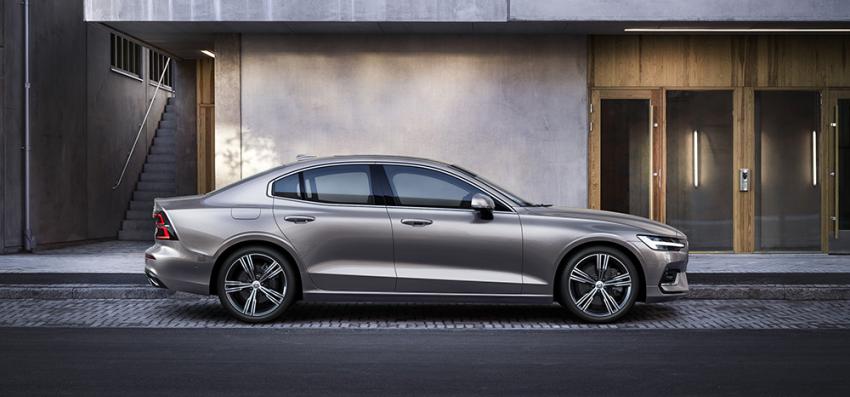Long range electric driving
Two levels of power and decent mileage (450 kilometres) for the Korean crossover ready to take on the EV market. High-capacity batteries and snappy engines characterize this urban crossover

Volvo is responsible for several motoring firsts. Solutions bravely introduced before anyone else and destined, with time, to became widely popular in the main Western markets. Just think of the station wagons of the '80s, and in some ways even Diesel engines. Volvo’s 200-series back in the 70s, introduced the diesel engine on a large scale, aided by the oil crisis of the time and the heavy taxation policies on petrol introduced in several countries.
With the S60, the Diesel option disappears from the price lists (though this option is maintained on the V60 wagon), in favour of petrol driven sedans or the evermore popular hybrid solution. A not-so-unexpected turnaround announced in 2018, well ahead of time on most competitors, during the official launch of the new S60 with manual transmissions being dropped in favour of the modern eight-speed automatic units with torque converter.
A Swede in “stars and stripes” clothing
Although, since 2010, the corporate structure of Volvo Car Corporation has been headed by a Chinese automotive giant, Geely, the industrial plans and design autonomy preserved all the know-how acquired by the Swedish company in almost a century since its foundation (1927). Renewed interest in overseas markets produced the first Volvo plant located in the United States, in Ridgeville, South Carolina, where the new S60 is produced and then exported globally. A modern sporty sedan, hybrid, tailored to Western needs, at home in the high-performance C segment cars in terms of technology and attractive looks.
First unveiled in the year 2000 and revamped with the second version ten years later, today's S60 has been completely redesigned in 2018 and went on sale in Italy from the following year. Characterized by a very penetrating design, almost coupe-like, means that the Swedish designers were willing to sacrifice some interior volume, but for that Volvo offers the more spacious and family-oriented V60.
Although faithful to the basic concepts of the previous generation, the S60 (S as in Sedan) is completely new, starting with the SPA (Scalable Product Architecture) platform now common to the entire top range of Volvos, from this sedan to the flagship S90 as well as the sport utility XC90.
As a traditional choice, Volvo choses to fill parallel segments, therefore the 60 series comes also as a station wagon V60 (V=Versatility), the crossover V60 Cross Country, and the SUV XC60, not to mention a rather close relationship with the Polestar 1, Volvo's electric and sport-oriented alter ego, still not imported (officially) in Italy.
The low and muscular design, with features borrowed from the more prestigious S90, well conceals its 4.80 metre length (4.76 x 1.85 m, height 1.43 m), with a generous 2.87 metre wheelbase that reduces overhangs, especially at the rear where the suspensions allow the rear section to be lowered, further emphasising the sporty look.
Inside, the interior space is dominated by totally digital instruments with a multifunction display in the middle and a raised central tunnel, home to the gearshift (eight-speed automatic only, also with paddle-shifters) and the driving mode selector for the more dynamic R-Design and Polestar versions.
The large vertical 9-inch monitor, which provides access to information, infotainment functions, navigation and driving data, allows for more immediate smartphone-style reading as well as a partial division of the information on the display. The range of ADAS devices, as one would expect, is particularly complete, from standard forward-collision warning and automated emergency braking to lane-departure warning and lane-keeping assist, just to mention a few main ones, further aided by the Pilot Assist system for semi-automatic driving, which, even without taking the hands off the steering wheel, allows the vehicle to follow the flow of traffic, relieving the driver's tension during long journeys on motorways.
Comfortable for four "Scandinavian" sized passengers, as the fifth middle rear passenger pays a heavy toll, in terms of comfort, to the raised tunnel that houses the 4WD transmission, under which the battery pack on the hybrid version is housed. The rear boot remains rather spacious, though, even with a spare wheel, with 471 litres of useful space accessible through an automated opening sensor.
More acceleration less top speed
Swedish does not mean sluggish. Quite the contrary, since the turbo-charged four cylinders and the additional electric motor (on the rear wheels), guarantees the S60 - in its maximum expression the T8 Polestar - over 400 HP and 65.2 kgm of maximum torque. So much for a family sedan! Performance peaks aside, the engine range has been designed to meet the demands of several Western markets, with North America and Europe first and foremost, where the four-cylinder Volvo T5, T6 and T8 series (compact 2-litre engines with aluminium head, direct injection and variable valve timing, with various power levels depending on the use of a turbocharger or a volumetric compressor) are the main protagonists. At the top of the range is the 405 HP Polestar, which boasts a scorching acceleration from 0 to 100 km/h in just 4.4 seconds, while limiting the top speed, just like the rest of the range, to "just" 180 km/h. Therefore, you can get your adrenaline rush sprinting away from a traffic light, if you are really looking for excitement, but faster than that is quite unnecessary, at least for those who drive a Volvo. The remaining engines, however, range from an entry level 190hp to 390 HP on the most powerful hybrid unit with a 65kW electric motor, able to move in zero-emission mode for over fifty kilometres.
The SPA platform mentioned earlier on, is particularly flexible on high-end cars, offering multiple options, always with a transversal front engine, but with the possibility of adding a 4WD system as in the case of the 250 HP B5 AWD model, relying on a traditional transmission with a central Haldex limited-slip differential. The addition of an electric motor to the rear axle also provides traction on all four wheels with the battery pack housed beneath the central tunnel freed from the mechanical transmission to the rear wheels.
The double wishbone suspension at the front is considered more stable than the usual McPherson system, giving the S60 better cornering precision, in line with the expectations of a car with a dynamic feel, with springs and shock absorbers calibrated to provide a certain amount of driving pleasure. The sportier Polestar version with 405 horsepower benefits from Öhlins shock absorbers with electronically adjustable settings, brakes with Brembo callipers enhanced for a more decisive braking and large tailor-made wheels. At the rear, a multi-link suspension benefits from a leaf spring made of composite materials, capable of guaranteeing effective absorption while reducing the structural dimensions so as to accommodate the electric motor at the rear.
While the flashy 20” wheels and 245/35 tires are reserved for the top of the range versions, the remaining S60s can rely on tires ranging from 215/60 R16 (but in Italy the standard is 225/50 R17) to 235/40 R19.
Two levels of power and decent mileage (450 kilometres) for the Korean crossover ready to take on the EV market. High-capacity batteries and snappy engines characterize this urban crossover
After 45 years Ford revamps the iconic Fiesta now in its seventh generation. Wide range of tailor-made solutions and a choice of engines with powers ranging between 70 and 200 HP, with 15 to 18inch steel or alloy wheels.
Renewed in its contents but not in its philosophy, the last generation of the Impreza maintains the famous characteristics of Subaru, permanent four-wheel drive and boxer engine, for the first time also in hybrid version.
